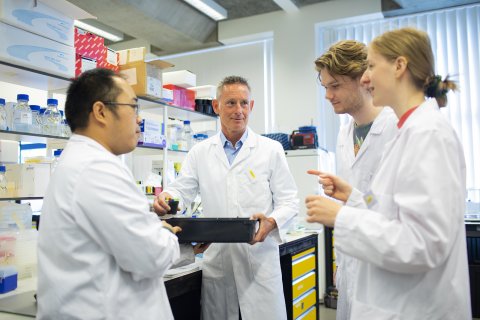Spinoza laureate Corné Pieterse: "I'm always solving new puzzles"
Synergy between plants and microbes enables more sustainable agriculture
Every year, more than a quarter of all harvests worldwide is lost due to diseases and plagues. The question of how plants can protect themselves against this leads Spinoza laureate Corné Pieterse to the most basic fundamentals of plant life. Even if only a few pieces of the puzzle are known, I can often already visualize what the complete puzzle will look like.

As the world's population continues to grow, and the impact of climate change steadily increases, our food supply faces many challenges. Countless harvests fail because of diseases and pests, which will become even more common due to the effects of climate change. Making plants more disease-resistant can help secure harvests, as well reduce the need for using pesticides.
According to biologist Corné Pieterse, the key to stronger plants lies in beneficial micro-organisms that live on the roots of plants. From their underground homes, these micro-organisms somehow boost the immune system of the entire plant. For his scientific breakthroughs that unfold how microbes help plants stay healthy, Pieterse received the Spinoza Prize, the highest award in Dutch academia.
Enormous potential
Pieterse's scientific approach and endurance are praised by peers worldwide. I am someone who takes a certain idea from plant biology and then completely unravels it. I will continue to do so, until we have determined how it all fits together,
says Pieterse, professor of Plant-microbe Interactions at Utrecht University.
The idea of adding bacteria to plants, which results in leaves becoming more resistant to diseases, led to a huge interest worldwide
Even when Pieterse was taking his first steps in scientific research, he already used this approach. A few years before Pieterse joined Utrecht University, his predecessors in Utrecht discovered that microbes boost the immune system of plants. But nobody knew the exact workings behind these observations,
says Pieterse. The idea of adding bacteria to plants, which results in leaves becoming more resistant to diseases, led to a huge interest worldwide. This was because it allows you to make crops more resistant to diseases in an organic way. People recognized this could have an enormous potential. But as long as the exact workings are unknown, you don't know how to make the most of it.
My team was the first to show how it actually works, which gave us an enormous reputation in the scientific world
Pieterse and colleagues then set a clear goal for themselves: to fully unravel how plants and microbes interact. We worked on that for years in a very focused way. Ultimately, we were the first ones to show how it actually works, which was really a breakthrough. My team gained an enormous reputation for this in the scientific world.
Beautiful puzzles
Focus and perseverance is what distinguishes Pieterse's work. If only a few pieces of the puzzle are known, I can often already visualize that it could become a very beautiful puzzle. And then of course, I want to complete that puzzle. And along the way, you also discover totally different pieces that can become another beautiful puzzle.
An example of such a new puzzle is his discovery that a plant hormone called jasmonic acid plays a major role in a plant’s defence. At that time, other scientists did not realise the hormone’s importance. My team decided to focus on that, eventually completing yet another puzzle.
Ground-breaking foundations
With his approach, Pieterse aims to deliver nothing less than ground-breaking science. Many researchers worldwide do 'me too work', as I tend to call it. They basically repeat what others have already invented. I don't find that particularly interesting myself. I prefer to work on things that nobody else has explored yet.
Many researchers basically repeat what others have already discovered. I prefer to work on things that nobody else has explored yet
Inspired by his pioneering work, many other scientists build upon the foundations Pieterse lays. His team’s discoveries have now been cited almost 35,000 times in scientific publications. Every year, that number grows by 3,500, which is a lot in plant biology.

Ambitious and fun
Besides a sharp focus, determination and a lot of perseverance, Pieterse says another factor is crucial: sociability. I'm proud to say that my team is really great,
says Pieterse. Certainly, doing excellent science is crucial, but to me, working together in a very pleasant way is just as important.
We always try to have fun in the group. We also talk about other things than just science, so we really get to know each other. It ensures that we work well together, create new things together and don’t begrudge each other anything. As my predecessor Johanna Westerdijk said: Working and partying creates beautiful minds.
Eminent predecessors
Westerdijk is the first in an impressive list of scientists who preceded Pieterse. Westerdijk founded the department of Plant Pathology at the University of Utrecht in 1917, which made her the first female professor in the Netherlands. She set the tone for plant research in Utrecht, by, among other things, unravelling the background of the Dutch elm disease. Plant biology in Utrecht has been performing at constantly high levels ever since, says Pieterse.
Spinoza building
With the brand-new Spinoza Prize for Pieterse, Utrecht University now has 20 Spinoza laureates. Remarkably, a quarter of them worked in the same building, the Hugo R. Kruyt building on Utrecht Science Park. Besides Pieterse, these laureates include Ben Scheres, Piet Gros, Albert Heck and Anna Akhmanova. I'm immensely proud to add my Spinoza Prize to our list,
says Pieterse. This is really a euphoric feeling.
Bridging the gap between plants and humans
As far as Pieterse is concerned, there are still plenty of scientific puzzles to be solved by his team. New pieces are waiting to be discovered right next to the Kruyt building, for example. On this location, a brand-new research facility will soon open its doors, under the name Netherlands Plant Eco-phenotyping Centre (NPEC). The facility features state-of-the-art equipment for plant research, available for use by plant biologists from all over the world.
Studying the plant microbiome, Pieterse and his team find many parallels between plants and humans
Moreover, research into the microbiome –all the micro-organisms that live on and inside a multicellular organism– is taking huge steps, thanks to continuously improving techniques.
Studying the plant microbiome, Pieterse and his team increasingly find many parallels between plants and humans. The great thing is that we can very easily make cross-overs between plant and human microbiomes,
says Pieterse. We’re doing quite innovative things in this respect, for example, in a multi-million Gravitation Programme, funded by the Dutch Research Council (NWO). Not surprisingly perhaps, this research also provides a new puzzle again. We've already seen the first pieces, and now we're trying to solve the full puzzle.

